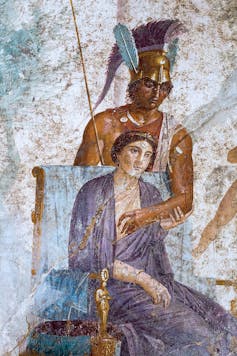 |
A view of the Belgravia Collection, with a George II giltwood pier mirror, circa 1740. Credit: Christie's Images Ltd 2023 |
The display, created by Robert Kime, also includes 19th-century furniture, highlighting the Gothic Revival, Aesthetic movement, and Arts and Crafts styles.
Featuring the works of some of the most renowned designers and craftsmen such as William and May Morris, Pugin, Crace, Godwin, and Liberty, the collection displays a captivating range of decorative art.
Among these are an intricate 'Hammersmith' carpet designed by William Morris, woven by Morris & Co, circa 1890, estimated at £70,000-100,000. An early Victorian Gothic Revival burr-walnut, sycamore, holly, boxwood, amaranth, and marquetry octagonal center table by Crace & Co., circa 1855, after a design by A.W.N. Pugin, is estimated at £25,000-40,000.
However, the furniture is not the only treasure in the Belgravia collection. The Pre-Raphaelite paintings on display are a true delight. John William Waterhouse's masterpiece, The Necklace (see main picture above), is a highlight of the collection, estimated at £150,000-250,000. The works of Sir Samuel Luke Fildes, R.A. and Edward Reginald Frampton, among others, offer a glimpse into the Victorian era's artistic splendor.
Featuring the works of renowned designers such as William and May Morris, Pugin, Crace, Godwin, and Liberty, the collection displays a captivating range of decorative art
 |
An important William De Morgan and William Morris framed tile panel (1876). Credit: Christie's Images Ltd 2023 |
This artwork is an excellent example of the synergy between the Arts and Crafts movement and the Pre-Raphaelite style, both of which were prominent during the 19th century. The Belgravia collection shows both the grandeur of English furniture and the beauty of Pre-Raphaelite art.
One of the highlights of the Berkshire part of the sale are three striking Japanese articulated dragons. The Myochin Nobumasa, dating back to the Edo Period (18th-19th Century) is more than 42½ inches or 108cm long. This rare piece, estimated at £120,000-180,000, shows the artistry and cultural richness of Japan.
An early painting by Ben Nicholson, O.M., titled The Red Necklace, created between 1916 and 1919, is estimated at £100,000-150,000 (see below). This captivating piece exemplifies Nicholson's mastery of color and composition, capturing the essence of the era.
There are also more contemporary works, such as the digital animation piece by Rob and Nick Carter. Titled Transforming Still Life Painting, this three-hour continuous loop animation, executed between 2009 and 2012, challenges the boundaries of artistic expression and blurs the lines between the physical and the digital realm. This artwork, in an artist's frame, is estimated to be worth £20,000-40,000.
The works show the synergy between the Arts and Crafts movement and the Pre-Raphaelite style, both of which were prominent during the 19th century
 |
The Red Necklace (1916~1919) by Ben Nicholson O.M. Credit: Christie's Images Ltd 2023 |
These installations, estimated at £10,000-15,000 each, explicate the artist's dedication to transforming waste into objects of beauty.
Colorful textiles by Robert Kime, with exquisite craftsmanship, complement the setting, along with comfortable furniture upholstered in William Morris fabrics.
Amid this ambiance are contemporary animal sculptures, including a striking Scops Owl by Geoffrey Dashwood.
This sculpture, signed by the artist himself, adds a touch of whimsy to the collection and is estimated at £1,500-2,500
The Guernsey part of the sale includes a superb group of 31 paintings by George Chinnery. The works display the artist's talent as a portrait painter and show a fascinating view of quotidian life in 19th-century India and China, and the surrounding landscapes. One of the highlights of this collection is the lively Portrait of William Jardine, estimated to be worth £40,000-60,000. The painter masterfully captures the personality of his subject and brings to life the sitters in his portraits.
The Guernsey collection includes a superb group of 31 paintings by George Chinnery. The works show a fascinating view of quotidian life in 19th-century India and China
 |
A Landscape in Macau with a Herdsman along a track by George Chinnery (174~1852). Credit: Christie's Images Ltd 2023 |
The collection also includes Chinese 'export' paintings and works of art inspired by the natural world in Asia. The exchange between East and West during this period, highlights the cultural intersections that shaped the artistic landscape.
Dutch 17th-century paintings by Jan Mijtens and Cornelis de Heem are displayed alongside sporting art, including works by John Wootton, Henry and William Barraud, and Charles Towne.
These works also display the wide range of artistic styles and subjects during the period. There are also three exquisite paintings by the Victorian artist John Atkinson Grimshaw, with the evocative A lane near Chester, 1881 leading the way (estimated at £70,000-100,000).
The Guernsey collection also has Georgian furniture juxtaposed with contemporary paintings. Among the highlights is Legong Dancer, 1979 by Balinese painter Dullah (1919-1996) estimated at £5,000-7,000 which captures traditional dance. Works by Australian artists Arthur Merric Bloomfield Boyd (1920-1999) and Lawrence M. Daws bring an antipodean flair to the collection. Boyd's Figure with Red Dog and Book, 1973, (estimated at £40,000-60,000), showcases the artist's distinctive style and exploration of the human form. The collection demonstrates the diverse artistic expression spanning continents and centuries and mixing East and West with both the traditional and contemporary.
Christies is holding the sale on 25th of May, 2023 in London at 8 King Street. St James's SW1Y 6QT United Kingdom. T: +44 (0)20 7839 9060.










































_Tate%5B1%5D.jpg)
_Tate%5B1%5D.jpg)
_Guildhall_Art_Gallery%5B1%5D.jpg)
_Private_Collection%5B1%5D.jpg)